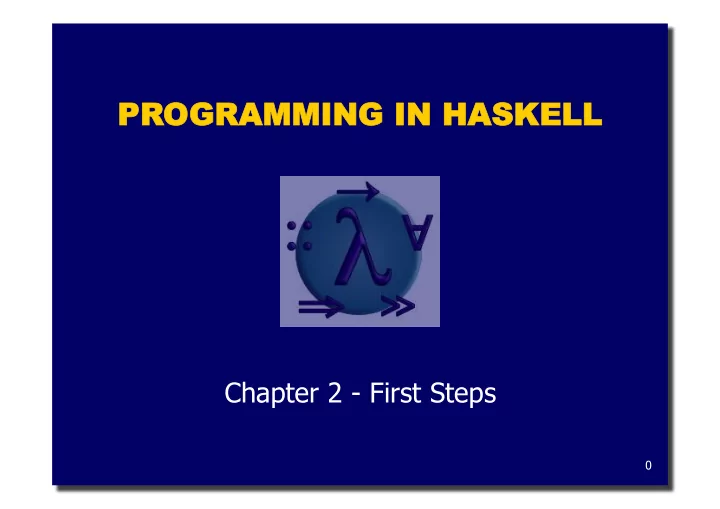

PROGR OGRAMMING NG IN N HA HASKE KELL LL Chapter 2 - First Steps 0
Glasgow Haskell Compiler ❚ GHC is the leading implementation of Haskell, and comprises a compiler and interpreter; ❚ The interactive nature of the interpreter makes it well suited for teaching and prototyping; ❚ GHC is freely available from: www.haskell.org/platform 1
Starting GHC The GHC interpreter can be started from the Unix command prompt % by simply typing ghci: % ghci GHCi, version 7.4.1: http://www.haskell.org/ghc/ :? for help Loading package ghc-prim ... linking ... done. Loading package integer-gmp ... linking ... done. Loading package base ... linking ... done. Prelude> 2
The GHCi prompt > means that the interpreter is ready to evaluate an expression. For example: > 2+3*4 14 > (2+3)*4 20 > sqrt (3^2 + 4^2) 5.0 3
The Standard Prelude Haskell comes with a large number of standard library functions. In addition to the familiar numeric functions such as + and *, the library also provides many useful functions on lists. ❚ Select the first element of a list: > head [1,2,3,4,5] 1 4
❚ Remove the first element from a list: > tail [1,2,3,4,5] [2,3,4,5] ❚ Select the nth element of a list: > [1,2,3,4,5] !! 2 3 ❚ Select the first n elements of a list: > take 3 [1,2,3,4,5] [1,2,3] 5
❚ Remove the first n elements from a list: > drop 3 [1,2,3,4,5] [4,5] ❚ Calculate the length of a list: > length [1,2,3,4,5] 5 ❚ Calculate the sum of a list of numbers: > sum [1,2,3,4,5] 15 6
❚ Calculate the product of a list of numbers: > product [1,2,3,4,5] 120 ❚ Append two lists: > [1,2,3] ++ [4,5] [1,2,3,4,5] ❚ Reverse a list: > reverse [1,2,3,4,5] [5,4,3,2,1] 7
Function Application In mathematics, function application is denoted using parentheses, and multiplication is often denoted using juxtaposition or space. f(a,b) + c d Apply the function f to a and b, and add the result to the product of c and d. 8
In Haskell, function application is denoted using space, and multiplication is denoted using *. f a b + c*d As previously, but in Haskell syntax. 9
Moreover, function application is assumed to have higher priority than all other operators. f a + b Means (f a) + b, rather than f (a + b). 10
Examples Mathematics Haskell f(x) f x f x y f(x,y) f (g x) f(g(x)) f x (g y) f(x,g(y)) f(x)g(y) f x * g y 11
Haskell Scripts ❚ As well as the functions in the standard library, you can also define your own functions; ❚ New functions are defined within a script, a text file comprising a sequence of definitions; ❚ By convention, Haskell scripts usually have a .hs suffix on their filename. This is not mandatory, but is useful for identification purposes. 12
My First Script When developing a Haskell script, it is useful to keep two windows open, one running an editor for the script, and the other running GHCi. Start an editor, type in the following two function definitions, and save the script as test.hs: double x = x + x quadruple x = double (double x) 13
Leaving the editor open, in another window start up GHCi with the new script: % ghci test.hs Now both the standard library and the file test.hs are loaded, and functions from both can be used: > quadruple 10 40 > take (double 2) [1,2,3,4,5,6] [1,2,3,4] 14
Leaving GHCi open, return to the editor, add the following two definitions, and resave: factorial n = product [1..n] average ns = sum ns `div` length ns Note: ❚ div is enclosed in back quotes, not forward; ❚ x `f` y is just syntactic sugar for f x y. 15
GHCi does not automatically detect that the script has been changed, so a reload command must be executed before the new definitions can be used: > :reload Reading file "test.hs" > factorial 10 3628800 > average [1,2,3,4,5] 3 16
Naming Requirements ❚ Function and argument names must begin with a lower-case letter. For example: myFun fun1 arg_2 x’ ❚ By convention, list arguments usually have an s suffix on their name. For example: xs ns nss 17
The Layout Rule In a sequence of definitions, each definition must begin in precisely the same column: a = 10 a = 10 a = 10 b = 20 b = 20 b = 20 c = 30 c = 30 c = 30 18
The layout rule avoids the need for explicit syntax to indicate the grouping of definitions. a = b + c a = b + c where where means b = 1 {b = 1; c = 2 c = 2} d = a * 2 d = a * 2 implicit grouping explicit grouping 19
Useful GHCi Commands Command Meaning :load name load script name :reload reload current script :edit name edit script name :edit edit current script :type expr show type of expr :? show all commands :quit quit GHCi 20
Exercises (1) Try out slides 2-8 and 14-17 using GHCi. (2) Fix the syntax errors in the program below, and test your solution using GHCi. N = a ’div’ length xs where a = 10 xs = [1,2,3,4,5] 21
(3) Show how the library function last that selects the last element of a list can be defined using the functions introduced in this lecture. (4) Can you think of another possible definition? (5) Similarly, show how the library function init that removes the last element from a list can be defined in two different ways. 22
Recommend
More recommend